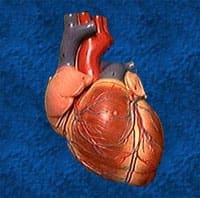| Recommendations for the Initial Clinical Assessment of Patients Presenting With Heart failure |
 |
|
Recommendations for the Initial Clinical Assessment of Patients Presenting With Heart failure Class I 2. A careful history of current and past use of alcohol, illicit drugs, current or past standard or alternative therapies, and chemotherapy drugs should be obtained from patients presenting with HF. 3. In patients presenting with HF, initial assessment should be made of the patient's ability to perform routine and desired activities of daily living. 4. Initial examination of patients presenting with HF should include assessment of the patient's volume status, orthostatic blood pressure changes, measurement of weight and height, and calculation of body mass index. 5. Initial laboratory evaluation of patients presenting with HF should include complete blood count, urinalysis, serum electrolytes (including calcium and magnesium), blood urea nitrogen, serum creatinine, fasting blood glucose (glycohemoglobin), lipid profile, liver function tests, and thyroidstimulating hormone. 6. Twelve-lead electrocardiogram and chest radiograph (PA and lateral) should be performed initially in all patients presenting with HF. 7. Two-dimensional echocardiography with Doppler should be performed during initial evaluation of patients presenting with HF to assess LVEF, LV size, wall thickness, and valve function. Radionuclide ventriculography can be performed to assess LVEF and volumes. 8. Coronary arteriography should be performed in patients presenting with HF who have angina or significant ischemia unless the patient is not eligible for revascularization of any kind. (Level of Evidence: B) Class IIa 1. Coronary arteriography is reasonable for patients presenting with HF who have chest pain that may or may not be of cardiac origin who have not had evaluation of their coronary anatomy and who have no contraindications to coronary revascularization. 2. Coronary arteriography is reasonable for patients presenting with HF who have known or suspected coronary artery disease but who do not have angina unless the patient is not eligible for revascularization of any kind. 3. Noninvasive imaging to detect myocardial ischemia and viability is reasonable in patients presenting with HF who have known coronary artery disease and no angina unless the patient is not eligible for revascularization of any kind. (Level of Evidence: B) 4. Maximal exercise testing with or without measurement of respiratory gas exchange and/or blood oxygen saturation is reasonable in patients presenting with HF to help determine whether HF is the cause of exercise limitation when the contribution of HF is uncertain. 5. Maximal exercise testing with measurement of respiratory gas exchange is reasonable to identify high-risk patients presenting with HF who are candidates for cardiac transplantation or other advanced treatments. (Level of Evidence: B) 6. Screening for hemochromatosis, sleep-disturbed breathing, or human immunodeficiency virus is reasonable in selected patients who present with HF. 7. Diagnostic tests for rheumatologic diseases, amyloidosis, or pheochromocytoma are reasonable in patients presenting with HF in whom there is a clinical suspicion of these diseases. 8. Endomyocardial biopsy can be useful in patients presenting with HF when a specific diagnosis is suspected that would influence therapy. (Level of Evidence: C) 9. Measurement of BNP* can be useful in the evaluation of patients presenting in the urgent care setting in whom the clinical diagnosis of HF is uncertain. (Level of Evidence: A) Class IIb 1. Noninvasive imaging may be considered to define the likelihood of coronary artery disease in patients with HF and LV dysfunction. (Level of Evidence: C) 2. Holter monitoring might be considered in patients presenting with HF who have a history of MI and are being considered for electrophysiologic study to document VT inducibility. (Level of Evidence: C) Class III 1. Endomyocardial biopsy should not be performed in the routine evaluation of patients with HF. (Level of Evidence: C) 2. Routine use of signal-averaged electrocardiography is not recommended for the evaluation of patients presenting with HF. (Level of Evidence: C) 3. Routine measurement of circulating levels of neurohormones (e.g., norepinephrine or endothelin) is not recommended for patients presenting with HF. (Level of Evidence: C) |
Reference |
| Direct quotes from this valuable reference: Hunt SA, Abraham WT, Chin MH, Feldman AM, et al. ACC/AHA 2005 Guideline Update for the Diagnosis and Management of Chronic Heart Failure in the Adult: a report of the American College of Cardiology/American Heart Association Task Force on Practice Guidelines (Writing Committee to Update the 2001 Guidelines for the Evaluation and Management of Heart Failure): developed in collaboration with the American College of Chest Physicians and the International Society for Heart and Lung Transplantation: endorsed by the Heart Rhythm Society. Circulation. 2005 Sep 20;112(12):e154-235. Epub 2005. Link: http://circ.ahajournals.org/cgi/content/full/112/12/e154 |
Initial Clinical Assessment of Patients Presenting With Heart failure
Reference(s)
National Institutes of Health, U.S. National Library of Medicine, DailyMed Database.
Provides access to the latest drug monographs submitted to the Food and Drug Administration (FDA). Please review the latest applicable package insert for additional information and possible updates. A local search option of this data can be found here.

